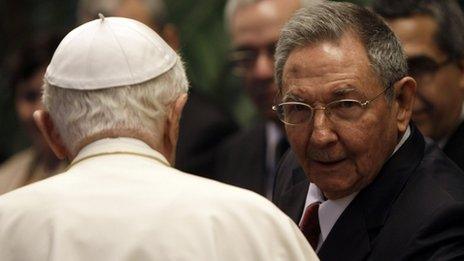Cuban Catholics hope to build first new church since 1959 revolution
- Published
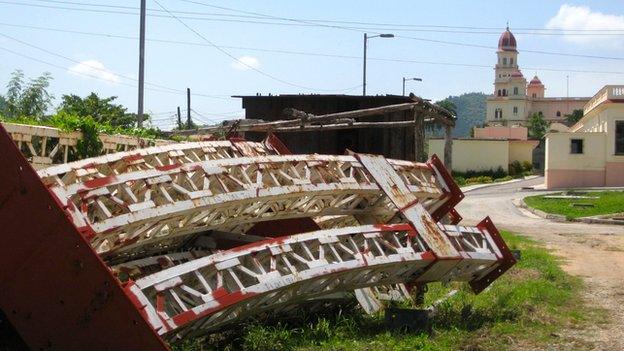
Metal bars salvaged from the stage built for Pope Benedict XVI's visit will be used to build a new church
On a hill behind Cuba's most important Catholic shrine, there is a heap of steel bars lying in the long grass.
They look abandoned, but the 25 tonnes of scrap metal are at the heart of a major religious recycling project - the plan is to transform them into the first Catholic church built in Communist Cuba since the 1959 revolution.
The engineer in charge of the project in Santiago de Cuba admits it is ambitious, not only because it is unprecedented but because the beams were once part of the stage built for Pope Benedict XVI's historic visit to the city in 2012.
"Re-using the metal means keeping alive the memory of something good for us Catholics. It gives it new life, so it can serve future generations," Fausto Veloz explains.
The team need one, final permit of five to get started.
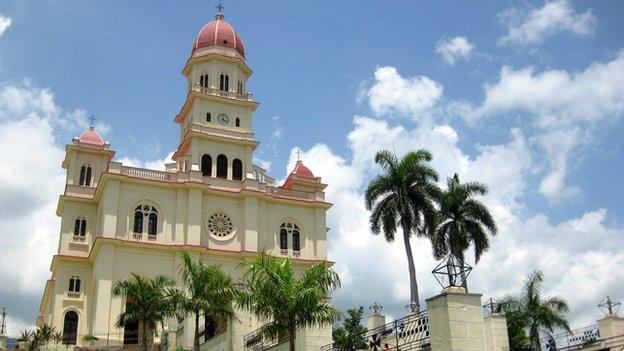
Our Lady of El Cobre is Cuba's most important Catholic shrine
But they argue there is also a pressing, practical motivation for the project: Cuba's Catholics say they need more places to worship.
Once officially atheist, this Communist-run island is now a secular state.
The days when believers would baptise their children in secret or attend mass surreptitiously in distant neighbourhoods have passed, and even Communist Party members now practice their religion openly.
And yet after Fidel Castro took power more than five decades ago, the Catholic Church was only permitted to renovate existing properties or rebuild where old ones collapsed.
New churches were never sanctioned, suggesting lingering ideological doubts on high.
Visible scars
The apparent change of heart is particularly timely in Santiago - a few months after the papal visit, Hurricane Sandy tore through the city with devastating results.
The little wooden church of San Pedrito was one of seven totally destroyed, made vulnerable by old age and poor maintenance. Another 28 churches were damaged.
The storm killed 11 people and wrought huge destruction across the east of the island.
Almost two years on, its traces are still visible.
Siboney was one of the hardest-hit areas. The beachgoers are now back but they sip their beer in the shell of their former sea-front cafe.
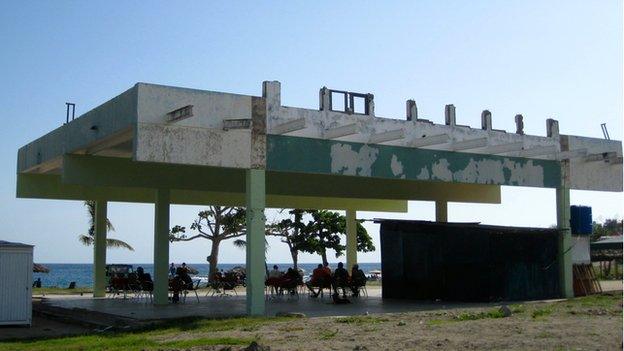
The beach-front cafe in Siboney has still not been rebuilt
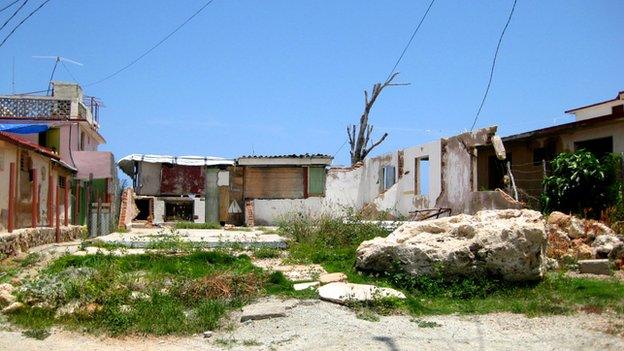
Boulders thrown by the hurricane still lie where they fell, sometimes in the middle of homes
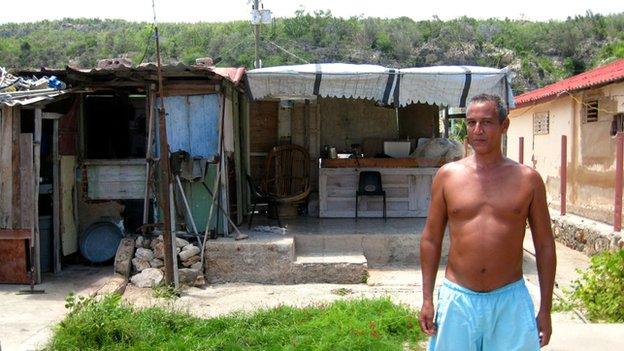
Locals like Roberto are still waiting for construction materials to rebuild their houses
The gaping holes in the local primary school have been filled in but the house opposite remains in ruins, complete with the huge boulder flung through its walls by the raging sea.
The owner was offered space in a state-run shelter but chose to stay, squeezed into the only corner of his home still standing and waiting for the construction materials the government promised.
Faint traces
Back in the city, a smooth concrete floor and the outline of the altar are all that remains of the 93-year-old church of San Pedrito.
Across the road, an elderly parishioner has stored the few items salvaged from the wreck - a couple of candlesticks, a wooden lectern and two chipped figurines from the nativity scene.
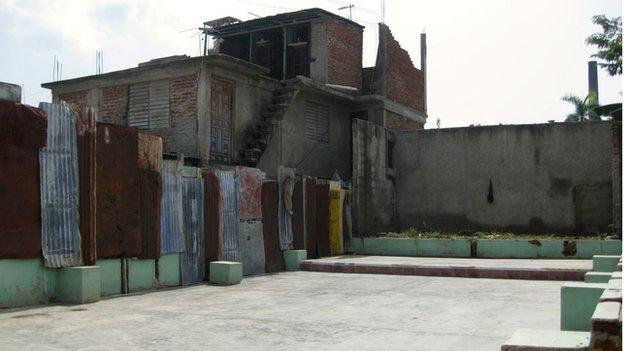
There is a gaping hole where the church of San Pedrito once stood

Marta Perez says she managed to salvage a few items from San Pedrito church
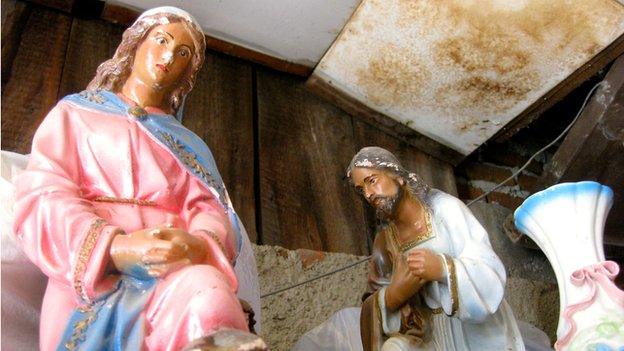
The nativity is one of the items she was able to save before thieves carried off the rest
"The rest were carried off by thieves," Marta Perez explains, shaking her head.
She says the congregation still gathers in the street outside for mass whenever a peripatetic priest can visit.
"We really need our church back," Ms Perez insists.
Ambitious plan
The archdiocese is planning to rebuild San Pedrito. But Communist Cuba's first, brand new church should take shape close by.
"The Catholic community is big here but they've never had a church," says Mr Veloz, gesturing towards the modern apartment blocks of Santiago's Jose Marti district.
The area was born after the revolution when religion was not a factor in town planning.
Nowadays, local Catholics meet to pray in casas de culto - private houses used for worship - but say they are struggling with gradually increasing numbers.
Across Cuba, the Catholic Church says around 60% of the population are baptised, though only a small fraction regularly practice their faith.
"I don't know how long it will take to complete but I'm sure we'll do it," Mr Veloz insists referring to the ground-breaking new church, surveying the site already allocated.
It is currently a car park, beside the district police station.
The steel beams - worth around $20,000 (£12,000) - were donated by the state when the stage was dismantled following Pope Benedict's visit.
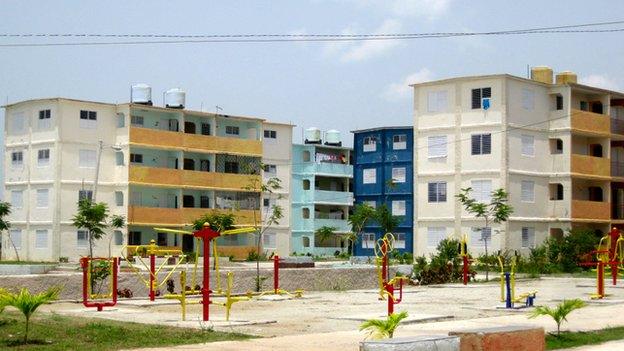
The neighbourhood in which the new church is planned is typical of those built after the revolution
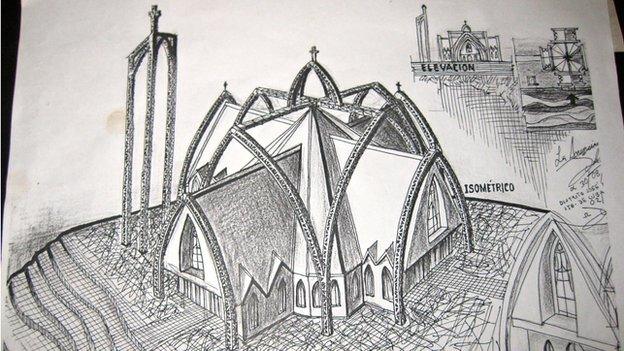
The plans for the new church are ambitious and the team still needs to raise $250,000
An architect's sketch envisages them in their new incarnation - soaring above the arched roof of the new Church of the Assumption, built to hold more than 600 worshippers and, Mr Veloz is keen to stress, withstand earthquakes and future hurricanes.
There is a fair way still to go - as well as the final permit, acquiring building materials here is always a challenge and there is the small task of raising $250,000 to finance the project - most likely from parishes abroad.
But Church officials are optimistic, sensing warming relations with the state.
"I think this doesn't only show improving attitudes in Cuba to the Catholic Church, but to churches in general. I think there's a better understanding of religious affairs," believes the Archbishop of Santiago, Dionisio Garcia.
Archbishop Garcia points to Cuba's closer ties with socialist but devout countries like Venezuela, in possible explanation.
"That's why we hope it won't only be this church that we build," he says. "We hope there'll be more."
- Published28 March 2012

- Published28 March 2012
